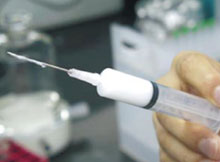|
by Lay Leng TAN

 ingapore employs nanotechnology in the development of methods for diagnosis and subsequent possible therapies. ingapore employs nanotechnology in the development of methods for diagnosis and subsequent possible therapies.
Why do scientists employ nanotechnology in cellular study when the living cells are typically in the micro range of 10–30 micrometres? Proteins and enzymes that drive the activities and functions of living cells actually interact on the molecular level, explains Kam W Leong, a professor of biomedical engineering at Johns Hopkins School of Medicine. Ligands (small molecules) bind to receptors on cell surfaces and convey signals through different pathways to reach the cell nucleus, which interprets and acts on messages.
Research has found that cells respond to the nanoscale features on surfaces to which they attach, with some oddities noted. For example, when they attach onto a nanofibre mesh, cells exhibit some interesting behaviour.
One hypothesis states that when cells attach to the nanofibre surface via ligand-receptor interaction, signals are transduced (transferred) into the cell, resulting in the up-regulation (a process that increases ligand-receptor interaction due to an increase in the number of available receptors) or down-regulation of some genes.
However, recent studies have shown that signal transduction depends not only on the density of the ligand but also on its clustering. This action in turn causes receptor clustering, which gives rise to a more potent response. Biologists believe this result has to do with proteins on the other side of the cell surface that come together to trigger the signal transduction.
|



 ingapore employs nanotechnology in the development of methods for diagnosis and subsequent possible therapies.
ingapore employs nanotechnology in the development of methods for diagnosis and subsequent possible therapies.